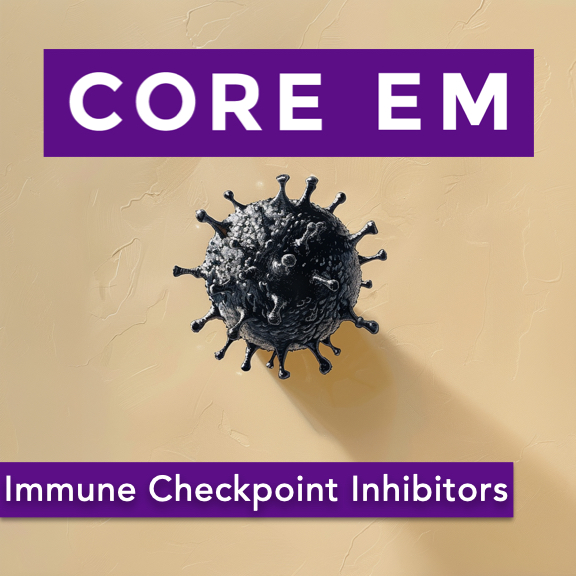Core EM - Emergency Medicine Podcast

Episode 200: Immune Checkpoint Inhibitors

We discuss a new class of medications, Immune Checkpoint Inhibitors, and their side effects.
Hosts:
Avir Mitra, MD
Brian Gilberti, MD
https://media.blubrry.com/coreem/content.blubrry.com/coreem/Immune_Checkpoint_Inhibitors.mp3
Download
Leave a Comment
Tags: Oncology
Show Notes
Overview of Immune Checkpoint Inhibitors (ICIs)
- ICIs are a relatively new class of oncologic drugs that have revolutionized cancer treatment.
- Unlike chemotherapy, ICIs help the immune system develop memory against cancer cells and adapt as the cancer mutates.
- Since their release in 2011, ICIs have expanded to 83 indications for 17 different cancers, with approximately 230,000 patients using them.
Mechanism of Action
- Cancer cells can evade the immune system by binding to T cell receptors that downregulate the immune response.
- ICIs work by blocking these receptors or ligands, preventing the downregulation and allowing T cells to proliferate and attack cancer cells.
- Common ICIs
Risks and Toxicities of ICIs
- ICIs can lead to autoimmune attacks on healthy cells due to immune system upregulation.
- Immune-related adverse effects (irAEs) include colitis, pneumonitis, dermatitis, hepatitis, and endocrine issues (e.g., hypothyroid, hypocortisolemia, hypophysitis).
- These toxicities can present as infections, making diagnosis challenging in the emergency room.
Management of ICI Toxicities in the ER
- Diagnosis: Look for signs that mimic infections (e.g., cough and fever in pneumonitis).
- Diagnostic Imaging in pneumonitis: If CXR is normal but suspicion is high, consider CT scans to differentiate conditions like pneumonitis from other issues such as malignancy-associated pleural effusion or acute pulmonary embolism.
- Treatment: The primary treatment for irAEs is steroids (e.g., prednisone 1 mg/kg). Start steroids early and hold the ICI to manage symptoms effectively and increase the likelihood of resuming ICI therapy later.
- Consider using antibiotics in combination with steroids if there is uncertainty about whether symptoms are due to infection or ICI toxicity.
- Coordinate care with the patient’s oncologist if possible
Disposition Decisions
- Patient disposition (admit vs. discharge) should depend on clinical presentation and severity.
- Coordination with oncology is crucial; they are often comfortable with starting steroids even if there is a potential infection.
- Patients can be discharged if symptoms are mild, but sicker patients with more complex presentations may require admission.
Take-Home Points
- ICIs are a new class of cancer drugs that effectively target cancer cells but come with unique immune-related toxicities.
- Diagnosing irAEs can be challenging due to symptom overlap with infections.
- The cornerstone of treatment is early administration of steroids and temporarily holding the ICI.
- Close collaboration with oncology teams is essential for optimal patient management.
Read More






 Visit Podcast Website
Visit Podcast Website RSS Podcast Feed
RSS Podcast Feed Subscribe
Subscribe
 Add to MyCast
Add to MyCast